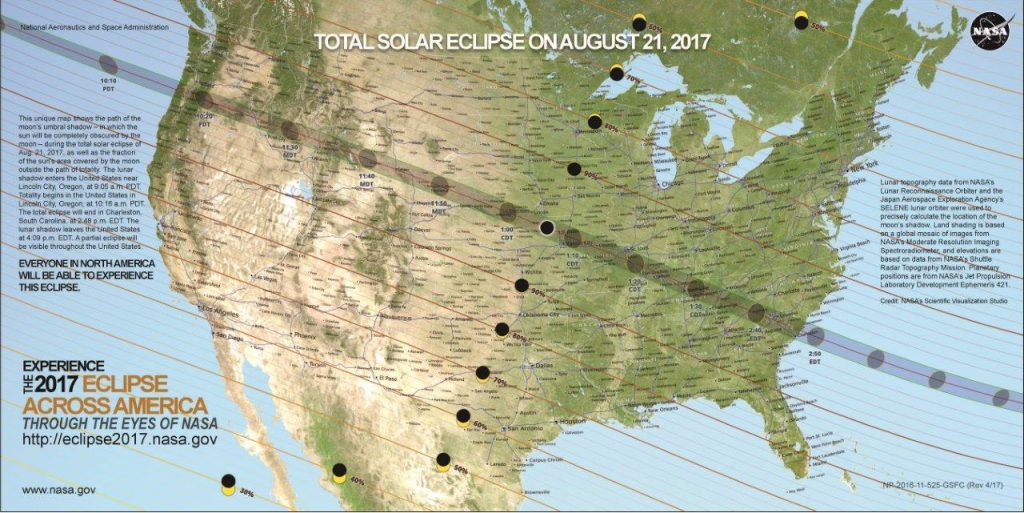26 July 2017
WASHINGTON, DC — On August 21, 2017, a total solar eclipse will be visible in a small band across the entire contiguous United States for the first time in nearly 100 years. In anticipation of the eclipse, several American Geophysical Union scientists are available to comment on the science of eclipses and what researchers can learn by observing them.

This map shows the path of the moon’s shadow, in which the sun will be completely obscured by the moon, during the total solar eclipse of Aug. 21, 2017, as well as the fraction of the sun’s area covered by the moon outside the path of totality. The lunar shadow enters the United States near Lincoln City, Oregon, at 9:05 a.m. PDT. Totality begins in the United States in Lincoln City, Oregon, at 10:16 a.m. PDT. The total eclipse will end in Charleston, South Carolina, at 2:48 p.m. EDT. The lunar shadow leaves the United States at 4:09 p.m. EDT. A partial eclipse will be visible throughout the United States.
Credit: NASA.
Paul Bryans is a solar physicist at the High Altitude Observatory within the National Center for Atmospheric Research in Boulder, Colorado. His expertise is on the atmosphere of the sun and how eruptive solar events can impact the Earth.
Email: [email protected]
Phone: +1 (303) 497-1574
Amir Caspi is a senior research scientist in the Division of Space Science and Engineering at Southwest Research Institute in Boulder, Colorado. He is a solar and stellar astrophysicist, specializing in high-energy processes on the sun like flares and heating of the solar corona. He analyzes data and develops new instrumentation to further this research, including sounding rockets, high-altitude balloons and satellites.
Email: [email protected]
Phone: +1 (303) 546-6351
Douglas Drob is a research physicist in the Space Science Division of the U.S. Naval Research Laboratory in Washington, D.C. He has over 25 years of experience measuring the upper mesosphere, thermosphere, and ionosphere and is currently calculating how the solar eclipse will perturb the upper atmosphere and ionosphere.
Email: [email protected]
Phone: +1 (202) 404-1292
Madhulika (Lika) Guhathakurta is an astrophysicist with the Heliophysics Science Division of NASA’s Goddard Space Flight Center in Greenbelt, Maryland, and is NASA’s lead scientist for the 2017 eclipse. Her research focuses on studying the solar corona and space weather and she has taken part in eight eclipse expeditions.
Email: [email protected]
Phone: +1 (202) 413-5177
Joseph Huba is a research physicist in the Plasma Physics Division at the U.S. Naval Research Laboratory in Washington, D.C. His main research interest is modeling the dynamics of Earth’s ionosphere-plasmasphere system. He has recently published an article predicting the impact of the solar eclipse on the ionosphere and plasmasphere.
Email: [email protected]
Phone: +1 (202) 767-6863
Philip Judge is a senior scientist at the High Altitude Observatory within the National Center of Atmospheric Research in Boulder, Colorado. His expertise is solar and stellar physics with significant interests in education, plasma physics, spectroscopy, and astrobiology. He is Editor-in-Chief of Open Astronomy.
Email: [email protected]
Phone: +1 (775) 674-7090
Padma A. Yanamandra-Fisher is a senior research scientist at the Space Science Institute in Boulder, Colorado, specializing in solar system outer planetary atmospheres and comets. She is currently planning to observe the upcoming total solar eclipse in polarized light to understand the distribution of coronal electrons during eclipses.
Email: [email protected]
Phone: +1 (909) 559 1021
###
The American Geophysical Union is dedicated to advancing the Earth and space sciences for the benefit of humanity through its scholarly publications, conferences, and outreach programs. AGU is a not-for-profit, professional, scientific organization representing more than 60,000 members in 139 countries. Join the conversation on Facebook, Twitter, YouTube, and our other social media channels.
Lauren Lipuma
+1 (202) 777-7396
[email protected]